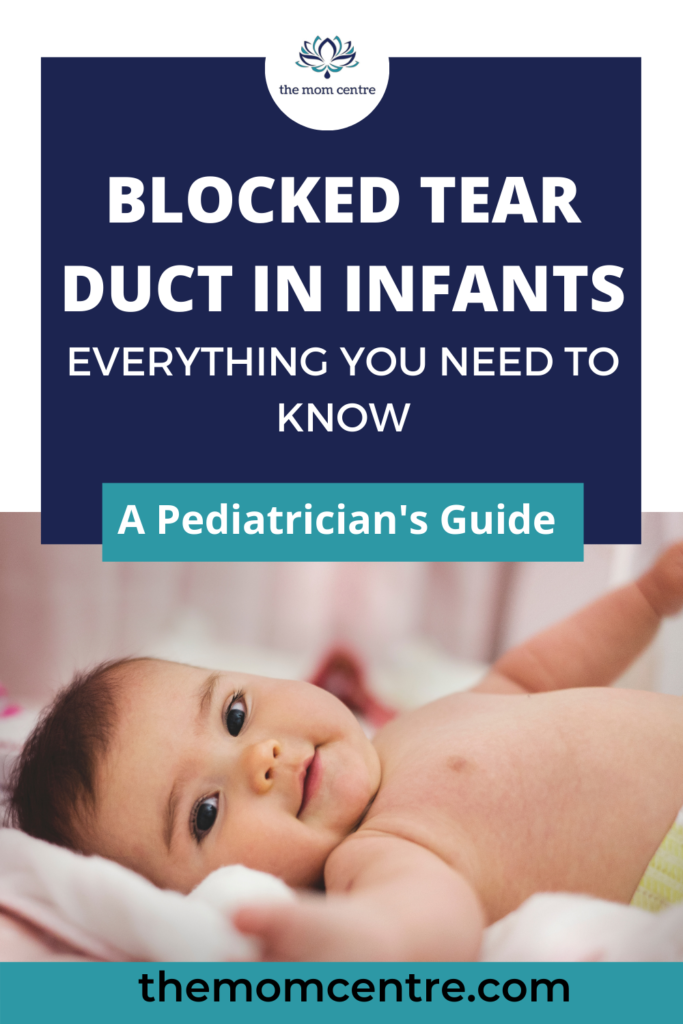The last thing you want to see is your newborn’s eyes tearing up. Many newborns and infants experience watering of eyes or mucus discharge from both or either eye. While the most common instinct of a mother is that of an eye infection, most frequently it is a blocked tear duct also known as the nasolacrimal duct.

In this article we will discuss what are tear ducts, why do they get blocked, what can you do at home to relieve this block, and when to visit your pediatrician or eye doctor.
We will also answer your frequently worrying questions about blocked tear ducts.
What is a blocked tear duct?
Our eyes are frequently lubricated with ‘tears’ which act as a protective film. These tears also protect us from infections and wash away any particles that may deposit. Tear ducts drain these tears into our noses.
These tiny channels are known as the tear ducts (also called the nasolacrimal duct). ‘Tear duct blockage’ means that there is blockage of the tiny channels (ducts) that drain tears from the inner corner of the eye into the nose.
How common is blocked tear duct in babies?
Blocked tear duct or blocked nasolacrimal duct is very common, especially in the newborn period. It is present in about 20%-50% of newborns but most of the obstruction opens up in about 4-6 weeks after birth. However, about 30% of children are free of symptoms by 3 months and 90% of all symptomatic tear duct blockage resolves by the first year of life.
What causes blocked tear ducts in babies?
Most commonly, blockage is due to the presence of a membrane at the level of the valve of Hasner, which is present at the nasal opening of the nasolacrimal duct. Other causes are
- Absence of NLD at birth
- Mucus filled lacrimal sac since birth
- Absence of valves since birth
What are the symptoms of a blocked tear duct?
A blocked tear duct may present as watering of eyes in an otherwise well child. Apart from continuous or intermittent watering from eye you may also notice following symptoms:
- Sticky eye lashes
- Mucus discharge from eyes
- Sore and worn off skin around eyes
- Redness of conjunctiva (white part of the eyes) is usually not seen, unless the child has been chronically rubbing his eyes.
- Mild swelling of the eye lids.
How to differentiate between blocked tear ducts and eye infections in babies?
The blocked tear duct mainly presents with watering from the eyes and symptoms described above.
An infected eye can have following symptoms to varying degrees:
- Pain
- Moderate to severe redness in the eye
- Intolerance to light also known as Photophobia
- a sickly child with fever, irritability, refusal to feed, decreased level of activity
- May be associated with cold, sore throat.
It’s always advisable to consult your doctor to differentiate between the conditions.
When should I see a doctor for my baby’s blocked tear duct?
There are few situations that warrant a consultation with your pediatrician or your eye doctor.
- If there is redness, discharge that has a yellowish tinge, swelling of the eyes.
- Persistent watering in a baby older than one and a half months needs a consultation with a doctor.
- A child who is ‘unwell’ requires consultation with a doctor. An “unwell” child could be any child with fever, reduced appetite, decreased activity.
How to treat a blocked tear duct at home?
It is important to consult your doctor for confirmation of the condition. Any treatment should be started only under proper medical guidance. The doctor might advise the following;
- Warm Compress: Use a clean towel and warm it using warm water. Use the warm towel to clean the eye, as well as to apply gentle pressure on the inner corner of the eye. Use separate towels for either of the eyes. If there is an infection of the eye, you may risk transmitting the infection to the uninfected eye.
- Criggler’s massage can be done at home as explained below.
How to perform Criggler’s massage at home?
- Wash your hands with soap and water and wipe them dry.
- Apply moderate pressure with the tip of your little finger on the skin between the inner end of your baby’s eye and nose, slide the finger downwards with the same amount of pressure towards the nose.
- You may use a gentle moisturizer or lubricant on your fingertip while doing so.
- This massage needs to be done 10-15 strokes per sitting, 3 sittings per day
How will the doctor treat blocked tear ducts in babies?
After confirmation of the Blocked nasolacrimal duct, your doctor might advise the following :
- Wait and watch as most cases resolve spontaneously
- Warm compress and Criggler’s massage is advised to be followed by parents at home
- Topical antibiotics might be started as per requirement
Most cases resolve in 4-6 weeks of treatment. If the condition persists, the doctor might consider surgical procedures like
- Probing
- Intubation
- Balloon Dacryoplasty
- Endoscopic Dacryocystorhinostomy
FAQs
No, tears are secreted normally. The normally secreted tears are unable to drain adequately due to blockage in the nasolacrimal duct or the tear duct.
There is no relationship between blocked tear duct and vision. Babies with tear duct blockage have normal vision.
Breast milk has not been proven beneficial or harmful on blocked tear duct as there is no proven relation between the two. It is always advisable to continue breast feeding the baby even if the baby has continuous watering which might be due to blockage of the tear duct.
However, we do not recommend using breast milk as eye drops to clear blocked duct.
Most cases of blocked nasolacrimal duct resolves by 1 year of age. It might be appropriate to wait until your child is 1 year old. However, certain cases might be more complex and the decision of surgical probing should lie with the consulting ophthalmologist.
Eye drops containing antibiotics are only recomended if there is associated eye infection. A blocked tear duct alone does not warrant any topical medication.
References:
- Vagge, A., Ferro Desideri, L., Nucci, P., Serafino, M., Giannaccare, G., Lembo, A., & Traverso, C. (2018). Congenital Nasolacrimal Duct Obstruction (CNLDO): A Review. Diseases, 6(4), 96. https://doi.org/10.3390/diseases6040096
- Perez Y, Patel BC, Mendez MD. Nasolacrimal Duct Obstruction. [Updated 2020 Oct 1]. In: StatPearls [Internet]. Treasure Island (FL): StatPearls Publishing; 2020 Jan-. Available from: https://www.ncbi.nlm.nih.gov/books/NBK532873/



